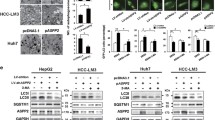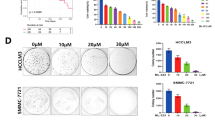Abstract
Autophagy is a survival mechanism that is activated in response to nutrient deprivation. The link between aberrant autophagy and cancer has been increasingly recognized. Survivin, an anti-apoptotic molecule, and the autophagy pathway are correlated with therapeutic responses to cancer. However, the role of autophagy in cancer progression remains unclear. Here, we generated survivin knockdown cells (survivin-KD) by introducing a short interfering RNA (siRNA) into hepatocellular carcinoma (HCC) cells, and we observed a 20 % reduction in the survival of these survivin-KD cells, as determined by MTT assay. In addition, an increased number of stress granules, increased positive staining by acridine orange and a shift in the high side scatter (SSC) cell population in flow cytometry analysis were observed in survivin-KD cells. Furthermore, electron microscopy revealed an increased number of autophagosomes in survivin-KD cells compared with scrambled control cells. Finally, we treated cells with an autophagy inhibitor, 3-MA, and observed a decrease in cell survival in survivin-KD cells compared with scrambled control cells. Our study suggests that an autophagy signal may be activated after the anti-apoptotic molecule survivin is suppressed. This finding implies that autophagy may be an alternative survival pathway in HCC cells and may provide a basis for the development of new therapeutic strategies for HCC.






Similar content being viewed by others
Abbreviations
- HCC:
-
Hepatocellular carcinoma
References
LaCasse EC, Baird S, Korneluk RG, MacKenzie AE. The inhibitors of apoptosis (IAPs) and their emerging role in cancer. Oncogene. 1998;17:3247–59.
Pennati M, Folini M, Zaffaroni N. Targeting survivin in cancer therapy: fulfilled promises and open questions. Carcinogenesis. 2007;28:1133–9.
Johnson ME, Howerth EW. Survivin: a bifunctional inhibitor of apoptosis protein. Vet Pathol. 2004;41:599–607.
Zaffaroni N, Pennati M, Colella G, Perego P, Supino R, Gatti L, et al. Expression of the anti-apoptotic gene survivin correlates with taxol resistance in human ovarian cancer. Cell Mol Life Sci. 2002;59:1406–12.
Giodini A, Kallio MJ, Wall NR, Gorbsky GJ, Tognin S, Marchisio PC, et al. Regulation of microtubule stability and mitotic progression by survivin. Cancer Res. 2002;62:2462–7.
Zhang M, Mukherjee N, Bermudez RS, Latham DE, Delaney MA, Zietman AL, et al. Adenovirus-mediated inhibition of survivin expression sensitizes human prostate cancer cells to paclitaxel in vitro and in vivo. Prostate. 2005;64:293–302.
Hanahan D, Weinberg RA. The hallmarks of cancer. Cell. 2000;100:57–70.
A new prognostic system for hepatocellular carcinoma: a retrospective study of 435 patients: The cancer of the liver italian program (clip) investigators. Hepatology. 1998;28:751–5.
Hsu C, Shen YC, Cheng CC, Hu FC, Cheng AL. Geographic difference in survival outcome for advanced hepatocellular carcinoma: implications on future clinical trial design. Contemp Clin Trials. 2010;31:55–61.
Sugioka A, Tsuzuki T, Kanai T. Postresection prognosis of patients with hepatocellular carcinoma. Surgery. 1993;113:612–8.
Primary liver cancer in Japan. Clinicopathologic features and results of surgical treatment. Liver cancer study group of Japan. Ann Surg. 1990;211:277–87.
Nagorney DM, van Heerden JA, Ilstrup DM, Adson MA. Primary hepatic malignancy: surgical management and determinants of survival. Surgery. 1989;106:740–8. discussion 748–749.
Paquet KJ, Koussouris P, Mercado MA, Kalk JF, Muting D, Rambach W. Limited hepatic resection for selected cirrhotic patients with hepatocellular or cholangiocellular carcinoma: a prospective study. Br J Surg. 1991;78:459–62.
Hu H, Li Z, Chen J, Wang D, Ma J, Wang W, et al. P16 reactivation induces anoikis and exhibits antitumour potency by downregulating akt/survivin signalling in hepatocellular carcinoma cells. Gut. 2011;60:710–21.
Mizushima N, Levine B. Autophagy in mammalian development and differentiation. Nat Cell Biol. 2010;12:823–30.
Levine B, Kroemer G. Autophagy in the pathogenesis of disease. Cell. 2008;132:27–42.
Tai CJ, Chin-Sheng H, Kuo LJ, Wei PL, Lu HH, Chen HA, et al. Survivin-mediated cancer cell migration through grp78 and epithelial-mesenchymal transition (emt) marker expression in mahlavu cells. Ann Surg Oncol. 2012;19:336–43.
Hung CS, Lin SF, Liu HH, Kuo LJ, Li LT, Su HY, et al. Survivin-mediated therapeutic efficacy of gemcitabine through glucose-regulated protein 78 in hepatocellular carcinoma. Ann Surg Oncol. 2012;19:2744–52.
Hung CS, Liu HH, Huang MT, Cheng CW, Kuo LJ, Ho YS, et al. Knockdown survivin expression reduces the efficacy of curcumin treatment in hepatocellular carcinoma cells. Ann Surg Oncol. 2012;19:3547–55.
Chiou JF, Tai CJ, Huang MT, Wei PL, Wang YH, An J, et al. Glucose-regulated protein 78 is a novel contributor to acquisition of resistance to sorafenib in hepatocellular carcinoma. Ann Surg Oncol. 2010;17:603–12.
Wang SK, Liang PH, Astronomo RD, Hsu TL, Hsieh SL, Burton DR, et al. Targeting the carbohydrates on hiv-1: interaction of oligomannose dendrons with human monoclonal antibody 2g12 and dc-sign. Proc Natl Acad Sci U S A. 2008;105:3690–5.
Sowinski S, Jolly C, Berninghausen O, Purbhoo MA, Chauveau A, Kohler K, et al. Membrane nanotubes physically connect t cells over long distances presenting a novel route for hiv-1 transmission. Nat Cell Biol. 2008;10:211–9.
Chang YJ, Chiu CC, Wu CH, An J, Wu CC, Liu TZ, et al. Glucose-regulated protein 78 (grp78) silencing enhances cell migration but does not influence cell proliferation in hepatocellular carcinoma. Ann Surg Oncol. 2010;17:1703–9.
Chiu HW, Lin JH, Chen YA, Ho SY, Wang YJ. Combination treatment with arsenic trioxide and irradiation enhances cell-killing effects in human fibrosarcoma cells in vitro and in vivo through induction of both autophagy and apoptosis. Autophagy. 2010;6:353–65.
Kanzawa T, Kondo Y, Ito H, Kondo S, Germano I. Induction of autophagic cell death in malignant glioma cells by arsenic trioxide. Cancer Res. 2003;63:2103–8.
Traganos F, Darzynkiewicz Z. Lysosomal proton pump activity: supravital cell staining with acridine orange differentiates leukocyte subpopulations. Methods Cell Biol. 1994;41:185–94.
Mobahat M, Narendran A, Riabowol K. Survivin as a preferential target for cancer therapy. Int J Mol Sci. 2014;15:2494–516.
Han L, Tang C, Yin C. Oral delivery of shRNA and siRNA via multifunctional polymeric nanoparticles for synergistic cancer therapy. Biomaterials. 2014;35:4589–600.
Necochea-Campion R, Chen CS, Mirshahidi S, Howard FD, Wall NR. Clinico-pathologic relevance of survivin splice variant expression in cancer. Cancer Lett. 2013;339:167–74.
Wang Q, Chen Z, Diao X, Huang S. Induction of autophagy-dependent apoptosis by the survivin suppressant ym155 in prostate cancer cells. Cancer Lett. 2011;302:29–36.
Ulasov IV, Tyler MA, Zhu ZB, Han Y, He TC, Lesniak MS. Oncolytic adenoviral vectors which employ the survivin promoter induce glioma oncolysis via a process of beclin-dependent autophagy. Int J Oncol. 2009;34:729–42.
Kang R, Zeh HJ, Lotze MT, Tang D. The beclin 1 network regulates autophagy and apoptosis. Cell Death Differ. 2011;18:571–80.
Niu TK, Cheng Y, Ren X, Yang JM. Interaction of beclin 1 with survivin regulates sensitivity of human glioma cells to trail-induced apoptosis. FEBS Lett. 2010;584:3519–24.
Hou MF, Kuo HC, Li JH, Wang YS, Chang CC, Chen KC, et al. Orai1/cracm1 overexpression suppresses cell proliferation via attenuation of the store-operated calcium influx-mediated signalling pathway in a549 lung cancer cells. Biochim Biophys Acta. 1810;2011:1278–84.
Wang JY, Chen BK, Wang YS, Tsai YT, Chen WC, Chang WC, et al. Involvement of store-operated calcium signaling in EGF-mediated cox-2 gene activation in cancer cells. Cell Signal. 2012;24:162–9.
Chang WC, Woon PY, Hsu YW, Yang S, Chiu YC, Hou MF. The association between single-nucleotide polymorphisms of orai1 gene and breast cancer in a Taiwanese population. Sci World J. 2012;2012:916587.
Yang S, Zhang JJ, Huang XY. Orai1 and STIM1 are critical for breast tumor cell migration and metastasis. Cancer Cell. 2009;15:124–34.
Huang WC, Chai CY, Chen WC, Hou MF, Wang YS, Chiu YC, et al. Histamine regulates cyclooxygenase 2 gene activation through orai1-mediated NFkappaB activation in lung cancer cells. Cell Calcium. 2011;50:27–35.
Acknowledgments
This study was supported by grants from Taipei Medical University and Shuang Ho Hospital (101TMU-SHH-9) and Ministry of Science and Technology (NSC-101-2314-B-038-016-MY3 and NSC-101-2314-B-038-029-MY3).
Conflicts of interest
None.
Author information
Authors and Affiliations
Corresponding author
Additional information
Yu-Jia Chang and Hsin-An Chen contributed equally to this study.
Rights and permissions
About this article
Cite this article
Chang, YJ., Li, LT., Chen, HA. et al. Silencing survivin activates autophagy as an alternative survival pathway in HCC cells. Tumor Biol. 35, 9957–9966 (2014). https://doi.org/10.1007/s13277-014-2257-6
Received:
Accepted:
Published:
Issue Date:
DOI: https://doi.org/10.1007/s13277-014-2257-6




